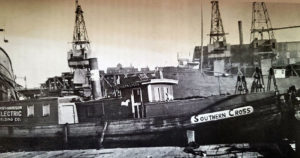Door County Almanak, No. 3, 1986
Although the age of steam was well launched on the Great Lakes by 1818, the revolution made possible by steam power did not reach the northern islands of Lake Michigan until half a decade after the Civil War. The fishermen of Washington Island were leaders in the conversion from sail and manpower to steam because gill net fishing during the season of 1870 was poorer than it had been for fourteen years. The nets had to be placed out a distance of fourteen or fifteen miles and in some locations in 70 fathoms of water. This made it difficult to reach them, one fishing boat was rowed for ten hours in one trip out to the nets. The sons of John O’Neil proposed that a small propeller be built for going out to the nets.
A little steamer was built by C.S. Fowles at his yard in Fort Howard for John O’Neil of Washington Harbor. She was launched at Green Bay on September 8, 1870, and named KITTY GAYLORD after their little daughter, and out of compliment to Captain G.A. Gaylord, the popular commander of the propeller ROCKET which served the islands. The dimensions of the GAYLORD, Official No, 14279, were 41.0 feet x 10.6 feet x 5.4 feet, and 13 gross 8 net tons. She had a high-pressure steam engine, with return flues.
Many of the fishermen and others in the community predicted that little steam fishing boats would be a failure, but after testing it proved to be just what the fishermen required for Washington Harbor and the adjoining islands. In a short time, it was destined to be the means of introducing steam in place of sails and oars, among the fishermen in the vicinity.
This novel experiment of the O’Neil brothers met with such decided success that their brother fishermen ordered the construction of steam-powered tugs. Captain H.L. Turner built a propeller at his yard in Green Bay for Messrs, Ranney & Shipman of Washington Harbor. Her measurements were 51.6 feet x 11.6 feet x 6.0 feet, and 17 gross, 8 net tons; and she was named the SARAH R. SHIPMAN, Official No. 115120.
Turner also built a steam fish tug for Ranney & Bradner of Washington Harbor. The POTTAWATTOMIE, Official No. 20434, was launched on Tuesday, May 23, 1871. Her dimensions were 48 feet x 11.6 feet x 5.5 feet, and 18 gross, 11 net tons. The machinery of this tug was built by Sutton Brothers, Buffalo, New York, and was installed by Spencer & Emeigh, the accomplished steam machine of Green Bay, who also did similar work for the SHIPMAN. Her wheel was of the approved “Philadelphia” pattern and was 42 inches in diameter. Her engine had a cylinder of 8 inches x 8 inches with a capacity of about 12 horsepower. On her trial trip on Saturday, May 27, the machinery of the POTTAWATTOMIE performed very well, and she made the run from the Light House at a speed of more than 10 miles per hour. She left Green Bay Monday for Washington Harbor under the command of Captain Bradner.
The completion of these boats inaugurated a revolution in the fishery business of these waters, making the business more certain in its results, and greatly lessening its hardships. As conducted with open sail craft, much depended on the wind and weather. The nets were often set from ten to twenty miles from shore; and in calm weather, the whole day frequently until late at night, was occupied in rowing out to the nets, overhauling them, and rowing home again. The men often worked all night because the fish had to be taken care of before they could go to sleep, even though they arrived home late at night and were wearied with the day’s work. They were frequently detained at the nets by storms, and the fish were spoiled before getting them home. With these steamers, however, the work was easy, results were certain, and one crew with a steamer could take care of more than double the capacity of nets and amount of fish than by the old method – in the same amount of time without being overworked.
The success of the first steam tugs induced the prompt adoption of these vessels by other fisheries during 1871. At St. Martin’s Island, the Driscoe Brothers were building a similar steamer to be launched as soon as possible. Her engines were being built at Buffalo by Sutton Brothers. Another steamer, for the Noe Brothers of Beaver Island, was being built by Sorenson at DePere. Her engine would come from the Monitor Foundry at Fort Howard. She was to be owned by Andrew Irr of Beaver Island, later of Washington Island and was being finished as rapidly as possible. These boats were all of the small class, costing but little fuel, and capable of making a very fair speed of 10 miles per hour. They had flush decks, unencumbered with any upper works which would generally be in the way and embarrassing in heavy weather. They burned wood which cost nothing more than the labor of cutting at the island.
Thus, the fishermen of Washington Island were the entrepreneurs who brought the steam-propelled industrial revolution to the fishing industry of northern Lake Michigan.

The Steam tug SOUTHERN CROSS, owned by Calvin H. Pooler, Jr. who fished from the McDonald Dock, Jackson Harbor, Washington Island in 1908. On February 4, 1913, she became the property of John I. Kinsey and Watt B. Davidson, who converted her into a welding steamer as shown in the photograph taken at Milwaukee in 1913. She was reportedly abandoned in 1921. Courtesy of Walter M. and Mary K. Hirthe, from Door County Almanak, Nov. 3


